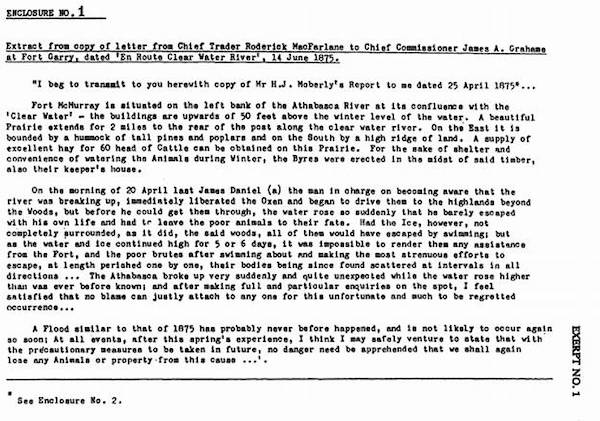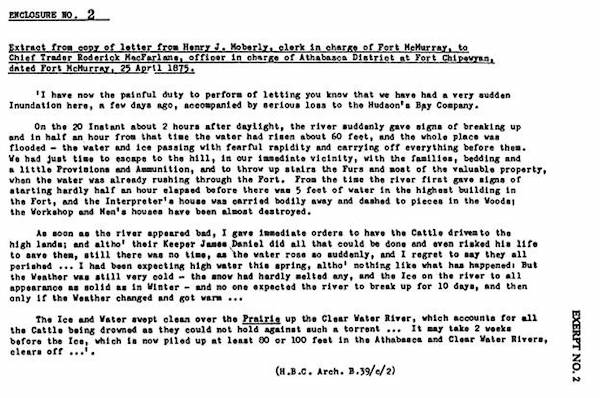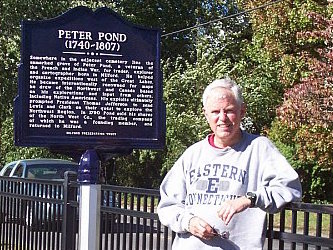TROUBLE AGAIN IN PETER POND COUNTRY
Fort McMurray, Alberta, the first white man passing through it being PP, is having its problems again. PPSer Darin Zandee writes that the Clearwater River has again been backed up by an ice jam on the Athabasca River into which it feeds, causing widespread flooding in the area.
"Fort McMurray is also suffering from very low oil price market as well so many people have been laid off since the beginning of April," Darin said in a May 3 email about the area that's the largest supply of oil or tar sands in the world and the industry around it. FM has also not been immune to the world-wide coronavirus infliction and is still coming back from the devastating wildfires of four years ago.
And he added: "The Peter Pond monument in Fort McMurray is under water and ice right now in Fort McMurray due to flooding."
Here are some historical items about the floods plus a recent news item.
"The biggest flood on record was in 1875 and there are some good journal entries from the HBC about that one. The top 12 floods when the Clearwater backed up against the Athabasca are (in order) are 1875, 1936, 1928, 1885, 1977, 1963, 1925, 1979, 1962, 1987, 1988, 1972, 1986, 1984, 1985, 1989, 1990.


Coronavirus in Canada
62,458 cases to date | 412 new today| 4,111 deceased
EDMONTON News
$100M in damage caused in Fort McMurray flood, mayor estimates
Alex Antoneshyn Digital Journalist
Published Monday, May 4, 2020 9:28AM MDT Last Updated Monday, May 4, 2020 4:26PM MDT
Fort McMurray flood damage estimated at $100MOfficials estimate the flooding damage in downtown Fort McMurray alone probably sits at $100 million. Jeremy Thompson reports.
EDMONTON -- Fort McMurray is again in recovery and rebuild mode, flooded exactly four years after a wildfire tore through the northern Alberta city.
One final evacuation order, for Garden Lane of the Draper area, was lifted at 6 p.m. on Sunday and municipal authorities have started guiding residents through the process of checking in on their homes and businesses.
Cora Dion is among those who are coming back to irreparable loss.
"The basement was under like five feet of water," she recalled.
"I stored everything down there as far as memories, so all my kids'baby pictures and stuff like that."
Volunteer Jay Woolner is back to his day job driving a garbage truck now that the city's food bank is running again.
"I drive down the streets and I see the devastation down here, and it's - it's overwhelming," he described.
Fort McMurray residents cleaning up after flooding 4 years to the day after devastating fire Some of the buildings to which 13,000 evacuated residents are returning are without utility service, and may be compromised or have internal structural damage, the municipality has warned.
On Monday, Wood Buffalo Mayor Don Scott, for the first time, put a number to the devastation.
"I would guess just based off what I've seen that I believe there's over $100 million in damages in this region, easily," Scott told media.
He said he would like to see the Alberta government make a comparable contribution to Fort McMurray's rebuild efforts as it did in 2013 after High River flooded.
While Premier Jason Kenney has called it likely that the municipality will qualify for dollars through the provincial Disaster Recovering Program, no commitment has been made.
"Details of any potential Disaster Recovery Program would have to be voted on by Cabinet before they could be made public, but the government recognizes the urgent need for relief," a statement from Timothy Gerwing, press secretary for Municipal Affairs Minister Kaycee Madu, read. "Stay tuned."
"Just given how much this region has given to Alberta and to Canada, I would be surprised if this region does not qualify for a significant DRP program," Scott said.
"I would hope that the provincial and federal governments would be coming to our aid in a significant way."
BOIL WATER ADVISORIES COULD LAST UNTIL SEPTEMBER: OFFICIALS A boil water advisory that remains in place for all neighbourhoods in Fort McMurray, Anzac, Draper, Greoire Lake Estates and Saprae Creek Estates could last five months, officials revealed Monday.
Alberta Health Services will not lift the advisory until the water treatment plant and 375-kilometre-long potable water distribution system is flushed, disinfected and tested.
Matthew Hough, deputy chief administration officer, said high river levels entered an overflow pipe and mixed with the drinking water supply.
"If I can use an analogy, the river water has created a film-like substance on the inside of our pipes, just you would need to clean a glass with milk that may have been left a little too long," he explained.
The Regional Municipality of Wood Buffalo says a plan to do this is pending government approval. Crews have already started flushing the plant; once given the go-ahead, they would then temporarily install flushing equipment on fire hydrants in residential neighbourhoods and flush them for 10 to 12 hours each day.
The plant's flushing will take 10 days. The three residential flushing phases are expected to each take 30 days, although Hough would like to see them done simultaneously. A final flushing of the entire system would take 20 days. As the work is completed, advisories could be lifted incrementally.
In the meantime, the hospital in Fort McMurray which was not breached by flood water but is located in the lower townsite, is receiving potable water from the Civeo plant north of Fort McMurray.
Hough said Civeo can only supply a limited number of users, including workcamps in the area, and that most houses do not have the same infrastructure as the hospital to receive supply.
The municipality anticipates being able to start the second phase of the cleaning process May 8.
Residents who are unable to boil water because their utilities are not yet back in service can pick up bottled water from the staging area at Macdonald Avenue and Morrison Street with ID that includes an address in a flood-affected area, or Red Cross registration.
On Monday, curbside waste collection and street sweeping also started, and the planning and development opened. Residents are asked to first use the online portal for things like building permits, property reports, and title and flood recovery information packages to respect COVID-19-related public health orders.
The evacuation alert for several communities in the downtown and lower townsite areas of Fort McMurray was issued April 26, and lead to a second state of local emergency on top of one issued for the COVID-19 pandemic.
The cause of the flooding was an ice jam on the Athabasca River, once more than 20 kilometres in length.
This is how ice buildup led to severe flooding in Fort McMurray
Northern Alta. flood evacuees to receive emergency cash payment
Evacuation orders lifted in Mackenzie County
Evacuees in Wood Buffalo as well as Mackenzie County, where another ice jam more than 40 kilometres in length on the Peace River caused flooding in the Fort Vermilion area, are eligible for emergency payments from the Alberta government.
Forecasters are not predicting any more jams to cause flooding in Fort McMurray.
KEVIN SWAIN'S YALE SENIOR ESSAY ON THE FUR TRADE
In PPS 53 you saw Yale senior Kevin Swain of Grand Haven, MI asking meet me about my knowledge of the fur trade due to my PPS website. He had been referred to me through his advisor and PPSer western history professor Jay Gitlin. We met in Jay's office in March, I gave them the latest PP book about Harold Innis and PP and answered some questions.
Attached please find the essay. Better not to put it in the body of the email since it's 50 pages. It's an interesting analytical piece covering many sources on dealing with the fur trade through memory. He also mentions how I fit into it all.
An excerpt from Kevin Swain's essay:
But fur trade hobbyists and historians are few and far between in modern society, and most people would admit they know very little about the fur trade. This is perhaps surprising in the Midwest, the history of which is rooted in the fur trade: In Michigan, second and third grade social studies curricula deal with "The Local Community" and "Michigan Studies," respectively, and while the curriculum guides discuss European/Native interactions and economic activities like lumbering and furniture manufacturing, neither mentions the fur trade by name. Similarly, the Tri-Cities Historical Museum-which sits steps away from where the La Framboise and Robinson's trading post stood-includes a single fur trade display among its nine permanent exhibits. For better or worse, its "Trading Post" exhibit is given no more space or prestige than the "Logging Camp" and "Agricultural Barn." This is not to say that local history should be thought of as a competition between time periods and events, but that the fur trade can fly under the radar even in towns which owe their start to it.
One notable exception to this rule can be found in Milford, Connecticut. Though not a city with a rich fur trading history, one notable fur trader and explorer named Peter Pond was born (1740) and died (1807) there. In Milford, retired journalist Bill McDonald runs the Peter Pond Society, whose website regards Pond as a fur trader that has been "overlooked" by history. McDonald's interest in the locality of the Peter Pond story-or at least his place of birth and death-is a carry-over of the same sort of local interest that inspired Grace Lee Nute with the Minnesota Historical Society. Historians are not required to be professionals nor academics, and sometimes a shared hometown is all it takes to be a keeper of memory. McDonald, then, is both a historian interested in the "canons of evidence"-and thus careful to find and analyze the details of Pond's life-as well as a keeper of memory with a personal connection to an aspect of the past.
Au revoir,
Bill

© 2000 to
The Peter Pond Society
website design by Daniel Ortoleva

